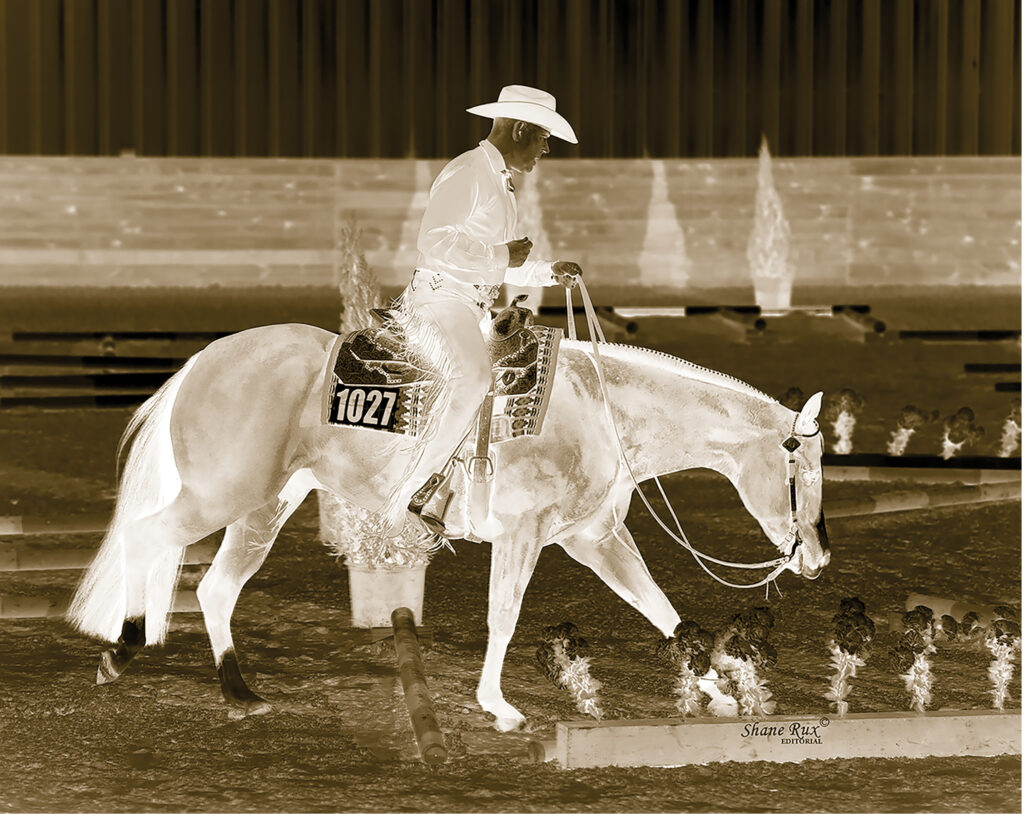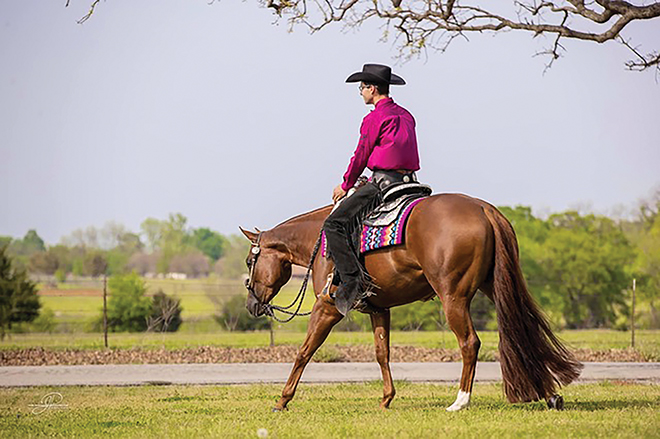Western Pleasure. In terms of entries, it’s traditionally been one of the most popular classes at American Quarter Horse Association (AQHA) and American Paint Horse Association (APHA) and other breed association events. Large purses and prestigious titles have traditionally drawn big numbers to the pen to be evaluated on quality of movement.
The National Snaffle Bit Association (NSBA) was even established back in 1983 with a mission statement that included: “to define, promote and improve the quality of the pleasure horse” and the NSBA continues to sanction and promote futurities featuring Western Pleasure classes for the youngest of show contenders under saddle.
One of the reasons for the popularity of the Western Pleasure class is that it is a platform for all other western classes, such as Western Riding, Horsemanship and Trail.
But Western Pleasure has not been without its controversies. It’s the event discipline keyboard warriors love to hate – drawing sometimes brutal criticism for “unnatural gaits and too-low headsets.’ It’s also the class that has by far undergone the most analysis and redefinition by sanctioning organizations.
But still … in the vast majority of cases, when seeking out a show horse that will excel in pattern classes, all-around trainers turn to the Western Pleasure trainers.
Nowhere was that more evident than watching the $40,000 NSBA Open Trail Challenge at the Sudden Impulse Futurity at the World Equestrian Center in Ocala, Florida this past April, where nearly all of the top 10 winners had been successfully shown in Western Pleasure.
Texas Western Pleasure trainer Aaron Moses is a 13-time All American Quarter Horse Congress Champion, five-time AQHA World Champion and NSBA World Champion. He says there are multiple reasons all-around trainers look first to Western Pleasure contenders but one of the main reasons is that so much of the groundwork has already been done for them.
“By starting with a horse that already has a strong foundation and has been seasoned at hauling and showing, the all-around trainers are able to concentrate their efforts on teaching that horse to do Trail, change leads and move more quickly into the desired event,” he explained. “They are also able to scout the Western Pleasure classes and look for the horses that would be best suited to their needs.”
Colorado trainer Chad Evans won that Open Trail Challenge at the Sudden Impulse futurity with Sugaray, a 2015 gelding by RL Best Of Sudden out of Whatscookngoodlookin, who was shown as a 3-year-old Western Pleasure horse by Ray Arnona. He said that he looks at Western Pleasure contenders for his Trail and Western Riding horses because of several factors.
“The quality of the movement, but also length of stride, will allow the horse to have the ability to do other classes,” he said. “I believe that there are other factors to be considered as well, such as the nature of the horse’s mind, which is a big one. If the horse has taken to the training and mentally enjoys the day in and day out process of being trained, or if he likes being around people, all that goes into horse show life.”
Every young prospect needs to have learned the basics to be able to progress and develop into a successful show horse. Ohio Western Pleasure trainer Blake Britton says having these basics already in place can help trainers spot potential for talent in a different event.
“I think the all-around trainers look at Western Pleasure prospects because they can see all the talent and the stride they have or don’t have,” he explained. “I feel like they’d be at a spot in the horse’s training that they can take it and run with it. Then they can start teaching them about the other events.”
Britton explained that all basic horse training is the same, no matter the event.
“Every horse we train for Western Pleasure should be able to stop, turn, back up and lope or trot off with correctness and be maneuverable,” he said.
Building a Foundation
Like with teaching a child, what’s important is a solid foundation. One task successfully accomplished leads to another, and so on. No matter what a Western Pleasure horse may graduate on to next, a solid training foundation will help set them up for success in the future.
“I think it’s important that all horses, no matter what their end goal may be, have a foundation of being ‘broke’ and have rideability that can be easily translated to any event,” Moses said. “I try to keep that in mind throughout the training process and I think it’s important not to get too far off track in creating a specialized horse and lose sight of its future.”
Training a horse to have self-carriage, for example, is an important element for any horse in any discipline. Since this is a big part of the foundational training Western Pleasure horses receive, it serves them well as they transition to something else later.
“If a pleasure horse has self-carriage, that will really carry over to the other classes,” Evans said. “When you are out in the pen by yourself, it’s important to have a horse that can carry itself through the pattern, through transitions, through obstacles and when backing up. All eyes are on you, so self-carriage is the name of the game.”
Moses acknowledges that while individual events have become more specialized, the intended purpose of the Western Pleasure class is to be the foundation class for the other events.
“I look for those qualities – balance, rhythm, and self-carriage– in a Western Pleasure contender and those are the same qualities that help a horse succeed as an all-arounder.”
There are tons of factors that apply to the importance of foundational training, according to Evans.
“I try to pick a horse that has had the homework done,” he explained. “A quality program focuses on self-carriage, the quality of movement and the horse’s brain. It’s important to take the time to teach the horse all that foundation. A nice pleasure horse is so fun to ride, and teaching it the other events only makes it more fun.”
Making the Transition
Since the basics are already in place when a Western Pleasure horse is purchased to transition into other events, it’s easier for its new trainer to play around and see what they might excel at next.
“In the beginning, I start going forward and just messing with different events,” Evans said. “I take them over poles, gallop through some lead changes, and see where their aptitude lies. Based on that, I try to decide the horse’s future, such as do we focus on one event and get it really good at it? Or, some horses enjoy learning a little of one thing and then a little of something else. For a Trail contender, I start with two-step trot overs and just work on those until the horse gets confident finding his steps. I think it’s a great way to teach them and the foundation of Trail.”
If they are lucky, an all-around trainer may find that those elements and maneuvers come with the Western Pleasure horse.
“I use a lot of the elements of the all-around events in my training process,” Moses said. “For example, one of the first things my young horses learn is how to counter canter and basically put their bodies in a lead change position. I use a lot of speed changes and acceleration at a stage of training, like galloping through their face, etc. This usually makes it a pretty easy transition. I feel like it’s a failure in my training or something I neglected, if a horse gets extremely lost or resistant when the elements of the all-around are introduced.”
Keeping The Future In Mind
Evans, Moses and Britton all agree that it’s important to keep in mind that a Western Pleasure horse can excel in other events and to keep that in mind throughout the training process.
“I’ve been lucky to have had Western Pleasure horses that have gone on to have success in other events,” Evans said. “A current one for me is Whose Your Bay Bae. He was a successful Western Pleasure horse, but you could tell he was going to be a great all-around horse by his movement to his carriage.”
By the time Evans got him Whose Your Bay Bae was mentally bored with the event.
“He loved the challenge of the all-around events,” Evans said. “He really loves to use himself and do athletic things.”
Moses said all Western Pleasure trainers should keep in mind that their own longevity depends on their ability to train horses for the long term.
“One of the best things we can do for the health of our event is to make sure our product is one that can translate to, and is desirable for, the all-around program,” he said.
Britton thinks the future is bright.
“The number of Western Pleasure horses that go on and become great all-around horses is extremely high,” he said. “That is the great thing about our breed – it’s so versatile that these horses can do many events.”







You must be logged in to post a comment Login